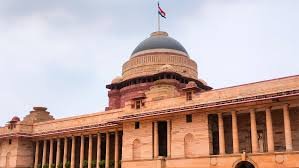NEW DELHI, July 25: Venues for different ceremonial functions, Rashtrapati Bhavan’s iconic ‘Durbar Hall’ and ‘Ashok Hall’ were on Thursday renamed ‘Ganatantra Mandap’ and ‘Ashok Mandap’, respectively.
Last year, the famous Mughal Gardens on the Rashtrapati Bhavan premises was rechristened ‘Amrit Udyan’.
“Rashtrapati Bhavan, the office and the residence of the president of India, is a symbol of the nation, and an invaluable heritage of the people. Continuous efforts are being made to make it more accessible to people. There has been a consistent endeavour to make the ambience of the Rashtrapati Bhavan reflective of the Indian cultural values and ethos,” a statement issued by the President’s Secretariat said.
Accordingly, President Droupadi Murmu is pleased to rename two of the important halls of Rashtrapati Bhavan — ‘Durbar Hall’ and ‘Ashok Hall’ — as ‘Ganatantra Mandap’ and ‘Ashok Mandap’, respectively, it said.
“Renaming ‘Ashok Hall’ as ‘Ashok Mandap’ brings uniformity in language and removes the traces of anglicisation while upholding the key values associated with the word ‘Ashok’,” said the statement issued on a day Murmu completed two years of her presidency.
‘Durbar Hall’, located under the central dome of Rashtrapati Bhavan, is the venue of important ceremonies and celebrations such as the presentation of national awards.
“The term ‘Durbar’ refers to courts and assemblies of Indian rulers and the British. It lost relevance after India became a Republic, that is, ‘Ganatantra’. The concept of ‘Ganatantra’ is deeply rooted in Indian society since the ancient times, making ‘Ganatantra Mandap’ an apt name for the venue,” the statement said.
Its corridor displays the busts of former Indian presidents, carved by noted sculptors from across the country. Six tall banners in deep red with the national emblem of India in gold also adorn the hall.
Against the wall is placed a fifth century AD statue of Lord Buddha on a crimson velvet background. In front of this statue is placed the president’s chair. Earlier, two thrones for the viceroy and the vicereine were placed at this spot.
On renaming the ‘Ashok Hall’, the president’s office said it was originally a ballroom.
“The word ‘Ashok’ connotes someone who is ‘free from all sufferings’ or is ‘bereft of any sorrow’,” it said.
Also, ‘Ashoka’ refers to Emperor Ashok, a symbol of unity and peaceful co-existence.
“The national emblem of the Republic of India is the lion capital of Ashok from Sarnath. The word also refers to the Ashok tree, which has deep significance in Indian religious traditions as well as arts and culture,” it added.
The hall is used for presentation of credentials by heads of missions of foreign countries and as a formal place of introductions for the visiting and Indian delegations prior to the commencement of the state banquets hosted by the president.
While the floor is wooden and has springs beneath the surface, the ceilings are decorated with oil paintings.
With the glow of six Belgium glass chandeliers, the hall provides a fascinating sight to visitors.
A loft was also designed in the state ballroom as a space for the orchestra.
However, it is now used for playing the national anthem during important functions, according to the Rashtrapati Bhavan.
Remarkable art pieces adorn the hall. These include a long case clock that was made in England and has a marking of British Clock Enfield by Cooke & Kelvey Limited, Calcutta.
The Persian style carpet, measuring 32 metres by 20 metres, was designed especially for the hall, keeping in mind its grandeur. The carpets were said to have engaged five hundred weavers for two years, according to its official description. (PTI)












